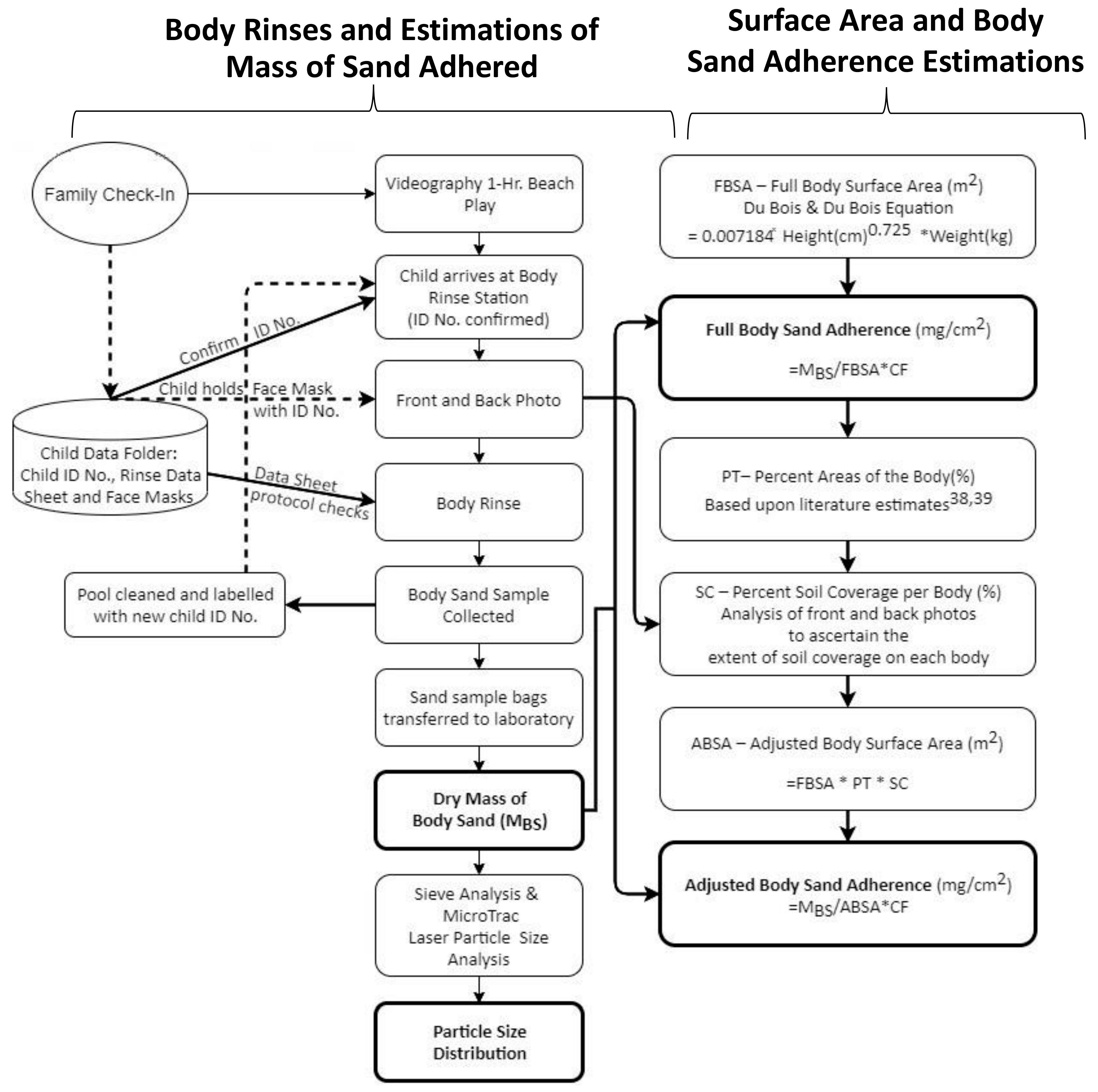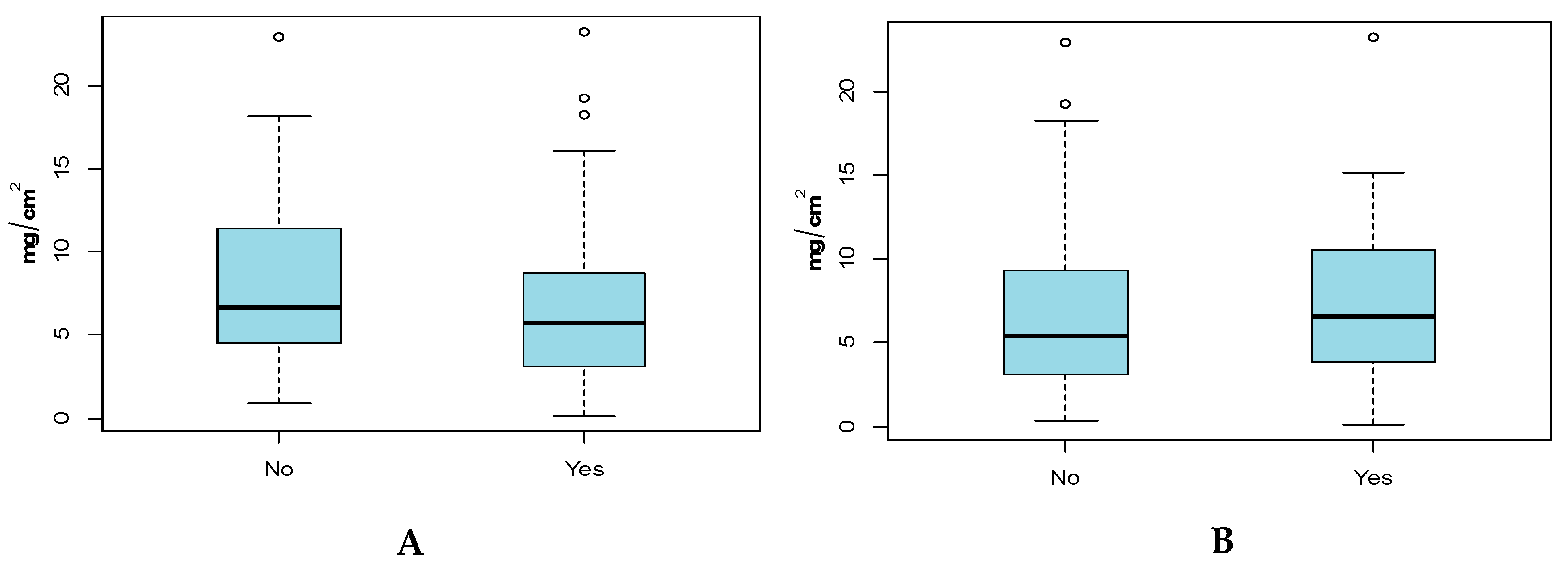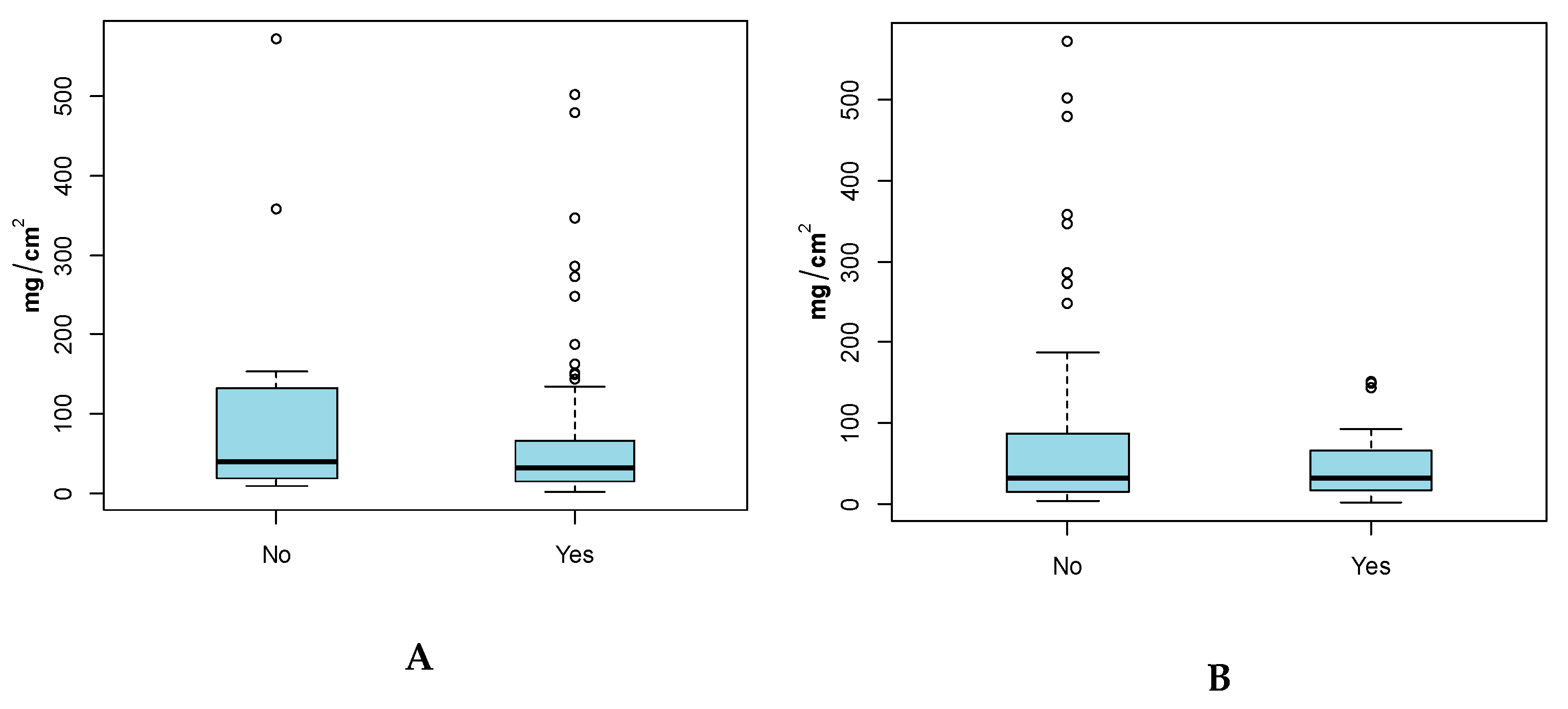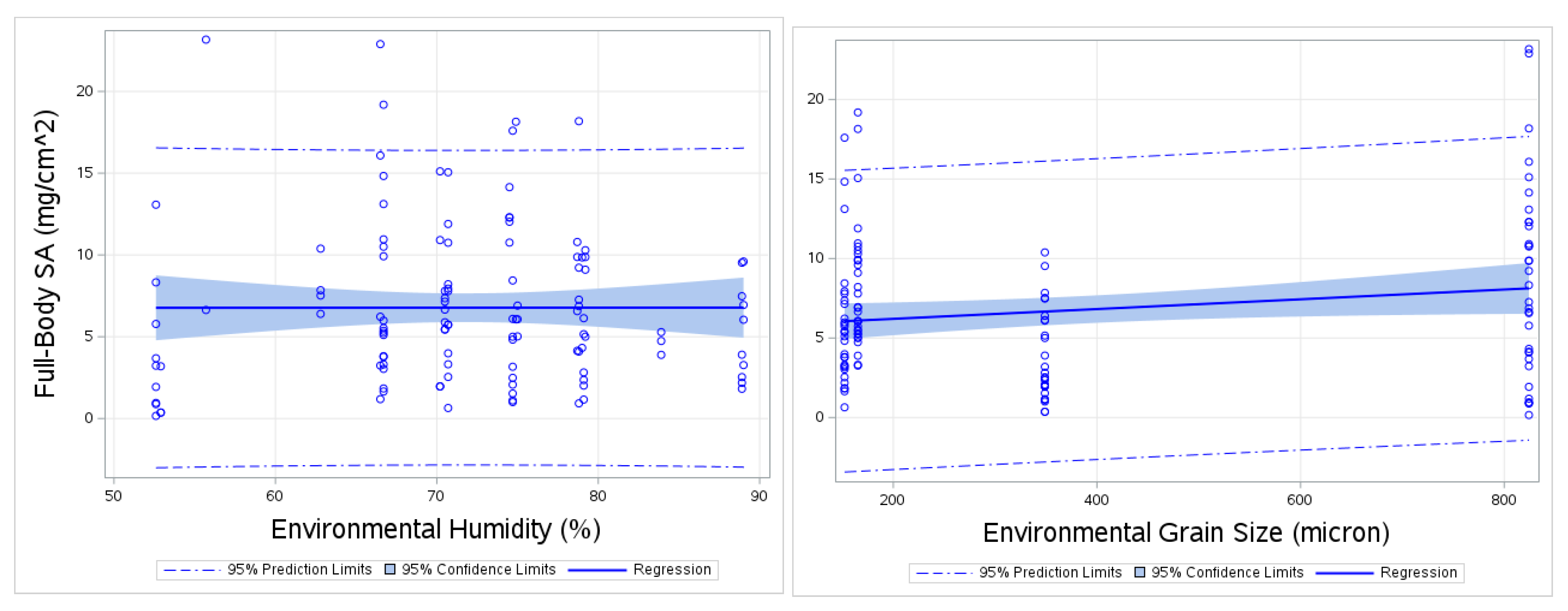Soil, Hand, and Body Adherence Measures across Four Beach Areas: Potential Influence on Exposure to Oil Spill Chemicals
Abstract
1. Introduction and Background
2. Methods
2.1. Subjects and Beach Locations
2.2. Hand Press Procedures
2.3. Body Rinse Procedures
2.4. Determination of Mass and Size of Sand Particles Adhered to Hands and Body
2.5. Surface Area Measurements
2.6. Body Soil Adherence Calculations
2.7. Collection of Ambient Sediment Samples in the Field and Environmental Parameters
2.8. Statistical Analysis
3. Results
3.1. Previous Findings on Hand SA
Summary of Variables for Hand and Body Adherence
3.2. Hand and Body (Full and Adjusted) SA by Sex
3.3. Hand and Body (Full and Adjusted) SA by Age Group
3.4. Hand and Body (Full and Adjusted) SA by Beach Locations
3.5. Effect of Sunscreen on Full-Body SA and Adjusted-Body SA
3.6. Full-Body SA Regression to Other Variables
Effects of Playing with Other Children, Last Location, Last Activity, and Clothing Type on Body SA
3.7. Exploring the Surface Area Coverage for Various Age-Groups
4. Discussion
5. Conclusions
Supplementary Materials
Author Contributions
Funding
Acknowledgments
Conflicts of Interest
References
- Child-Specific Exposure Factors Handbook. Available online: https://ordspub.epa.gov/ords/eims/eimscomm.getfile?p_download_id=36528 (accessed on 10 June 2020).
- AuYeung, W.; Canales, R.A.; Beamer, P.; Ferguson, A.C.; Leckie, J.O. Young children’s hand contact activities: An observational study via videotaping in primarily outdoor residential settings. J. Expo. Sci. Environ. Epidemiol. 2006, 16, 434–446. [Google Scholar] [CrossRef] [PubMed]
- AuYeung, W.; Canales, R.; Beamer, P.; Ferguson, A.; Leckie, J. Young children’s mouthing behavior: An observational study via videotaping in a primarily outdoor residential setting. J. Child. Heal. 2004, 2, 271–295. [Google Scholar] [CrossRef]
- Beamer, P.; Canales, R.A.; Leckie, J.O. Developing probability distributions for transfer efficiencies for dermal exposure. J. Expo. Sci. Environ. Epidemiol. 2008, 19, 274–283. [Google Scholar] [CrossRef] [PubMed]
- Beamer, P.I.; Canales, R.A.; Ferguson, A.C.; Leckie, J.O.; Bradman, A. Relative Pesticide and Exposure Route Contribution to Aggregate and Cumulative Dose in Young Farmworker Children. Int. J. Environ. Res. Public Health 2012, 9, 73–96. [Google Scholar] [CrossRef] [PubMed]
- Tsou, M.; Özkaynak, H.; Beamer, P.; Dang, W.; Hsi, H.; Jiang, C.; Chien, L. Mouthing activity data for children aged 7 to 35 months in Taiwan. J. Expo. Sci. Environ. Epidemiol. 2015, 25, 388–398. [Google Scholar] [CrossRef] [PubMed]
- Zartarian, V.G.; Ferguson, A.C.; Leckie, J.O. Quantified mouthing activity data from a four-child pilot field study. J. Expo. Anal. Environ. Epidemiol. 1998, 8, 543–552. [Google Scholar]
- Tulve, N.; Suggs, J.; McCurdy, T.; Cohen-Hubal, E.; Moya, J. Frequency of mouthing behavior in young children. J. Expo. Sci. Environ. Epidemiol. 2002, 12, 259–264. [Google Scholar] [CrossRef]
- Black, K.; Shalat, S.L.; Freeman, N.C.G.; Jimenez, M.; Donnelly, K.C.; Calvin, J.A. Children’s mouthing and food-handling behavior in an agricultural community on the US/Mexico border. J. Expo. Anal. Environ. Epidemiol. 2005, 15, 244–251. [Google Scholar] [CrossRef]
- Xue, J.; Zartarian, V.; Jacqueline, M.; Natalie, F.; Paloma, B.; Kathy, B.; Nicolle, T.; Shalat, S. A meta-analysis of children’s hand-to-mouth frequency data for estimating nondietary ingestion exposure. Risk Anal. 2007, 27, 411–420. [Google Scholar] [CrossRef]
- Moore, S.W. Developmental genes and cancer in children. Pediatr. Blood Cancer. 2009, 52, 755–760. [Google Scholar] [CrossRef]
- Selevan, S.G.; Kimmel, C.A.; Mendola, P. Identifying critical windows of exposure for children’s health. Environ. Health Perspect. 2000, 108, 451–455. [Google Scholar] [CrossRef] [PubMed]
- Khan, S.; Cao, Q.; Zheng, Y.M.; Huang, Y.Z.; Zhu, Y.G. Health risks of heavy metals in contaminated soils and food crops irrigated with wastewater in Beijing, China. Environ. Pollut. 2008, 152, 686–692. [Google Scholar] [CrossRef] [PubMed]
- Khan, K.; Lu, Y.; Khan, H.; Ishtiaq, M.; Khan, S.; Waqas, M.; Wei, L.; Wang, T. Heavy metals in agricultural soils and crops and their health risks in Swat District, northern Pakistan. Food Chem. Toxicol. 2013, 58, 449–458. [Google Scholar] [CrossRef] [PubMed]
- Ruby, M.V.; Lowney, Y.W. Selective soil particle adherence to hands: Implications for understanding oral exposure to soil contaminants. Environ. Sci. Technol. 2012, 46, 12759–12771. [Google Scholar] [CrossRef] [PubMed]
- Usman, M.; Faure, P.; Ruby, C.; Hanna, K. Remediation of PAH-contaminated soils by magnetite catalyzed Fenton-like oxidation. Appl. Catal. B Environ. 2012, 117–118, 10–17. [Google Scholar] [CrossRef]
- Gan, S.; Lau, E.V.; Ng, H.K. Remediation of soils contaminated with polycyclic aromatic hydrocarbons (PAHs). J. Hazard. Mater. 2009, 172, 532–549. [Google Scholar] [CrossRef]
- Hu, X.Y.; Wen, B.; Shan, X.Q. Survey of phthalate pollution in arable soils in China. J. Environ. Monit. 2003, 5, 649–653. [Google Scholar] [CrossRef]
- Vikelsoe, J.; Thomsen, M.; Carlsen, L. Phthalates and nonylphenols in profiles of differently dressed soils. Sci. Total Environ. 2002, 296, 105–116. [Google Scholar] [CrossRef]
- Wang, J.; Chen, G.; Christie, P.; Zhang, M.; Luo, Y.; Teng, Y. Occurrence and risk assessment of phthalate esters (PAEs) in vegetables and soils of suburban plastic film greenhouses. Sci. Total Environ. 2015, 523, 129–137. [Google Scholar] [CrossRef]
- Wright, M.E.; Abdelzaher, A.M.; Solo-Gabriele, H.M.; Elmir, S.; Fleming, L.E. The Inter-Tidal Zone is the Pathway of Input of Enterococci to a Subtropical Recreational Marine Beach. Water Sci. Technol. 2011, 63, 542–549. [Google Scholar] [CrossRef]
- Shibata, T.; Solo-Gabriele, H.M. Quantitative microbial risk assessment of human illness from exposure to marine beach sand. Environ. Sci. Technol. 2012, 46, 2799–2805. [Google Scholar] [CrossRef] [PubMed]
- Exposure Factors Handbook: 2011 Edition (Final Report). Available online: https://cfpub.epa.gov/ncea/risk/recordisplay.cfm?deid=236252 (accessed on 10 June 2020).
- Ferguson, A.; Bursac, Z.; Johnson, W.; Davis, J. Computer controlled chamber measurements for clay adherence relevant for potential dioxin exposure through skin. J. Environ. Sci. Heal. Part A 2012, 47, 382–388. [Google Scholar] [CrossRef] [PubMed]
- Ferguson, A.C.; Bursac, Z.; Biddle, D.; Coleman, S.; Johnson, W. Soil–skin adherence from carpet: Use of a mechanical chamber to control contact parameters. J. Environ. Sci. Heal. Part A 2008, 43, 1451–1458. [Google Scholar] [CrossRef] [PubMed]
- Ferguson, A.C.; Biddle, D.; Coleman, S.; Bursae, Z.; Johnson, W. In-Vitro Soil Adherence for Dermal Exposure Using a Controlled Mechanical Chamber. J. Appl. Sci. Res. 2009, 5, 232–243. [Google Scholar]
- Kissel, J.C.; Richter, K.Y.; Fenske, R.A. Factors affecting soil adherence to skin in hand-press trials. Bull. Environ. Contam. Toxicol. 1996, 56, 722. [Google Scholar] [CrossRef]
- Shoaf, M.B.; Shirai, J.H.; Kedan, G.; Schaum, J.; Kissel, J.C. Child dermal sediment loads following play in a tide flat. J. Expo. Sci. Environ. Epidemiol. 2005, 15, 407–412. [Google Scholar] [CrossRef]
- Kissel, J.C.; Richter, K.Y.; Fenske, R.A. Field measurement of dermal soil loading attributable to various activities: Implications for exposure assessment. Risk Anal. 1996, 16, 115–125. [Google Scholar] [CrossRef]
- Holmes, K.K.; Shirai, J.H.; Richter, K.Y.; Kissel, J.C. Field measurement of dermal soil loadings in occupational and recreational activities. Environ. Res. 1999, 80, 148–157. [Google Scholar] [CrossRef]
- Yamamoto, N.; Takahashi, Y.; Yoshinaga, J.; Tanaka, A.; Shibata, Y. Size distributions of soil particles adhered to children’s hands. Arch. Environ. Contam. Toxicol. 2006, 51, 157–163. [Google Scholar] [CrossRef]
- Bergstrom, C.; Shirai, J.; Kissel, J. Particle size distributions, size concentration relationships, and adherence to hands of selected geologic media derived from mining, smelting, and quarrying activities. Sci. Total Environ. 2011, 409, 4247–4256. [Google Scholar] [CrossRef] [PubMed]
- Ferguson, A.; Dwivedi, A.; Brown, K. Soil–skin adherence measures from hand press trials in a gulf study of exposures. J. Expo. Sci. Environ. Epidemiol. (Under Review).
- Ferguson, A.; Del Donno, C.; Obeng-Gyasi, E.; Mena, K.; Altomare, T.; Guerrero, R.; Gidley, M.; Montas, L.; Solo-Gabriele, H. Children exposure-related behavior patterns and risk perception associated with recreational beach use. Int. J. Environ. Res. Public Health. 2019, 16, 2783. [Google Scholar] [CrossRef]
- Tomenchok, L.; Gidley, M.L.; Mena, K.D.; Ferguson, A.C.; Solo-Gabriele, H. Children’s abrasions in recreational beach areas and a review of possible wound infections. Int. J. Expo. Res. Public Heal. 2020, 17, 4060. [Google Scholar] [CrossRef]
- Perone, H.; Rattler, K.; Ferguson, A.; Mena, K.; Solo-Gabriele, H. Analysis of methods to determine hand surface area of children less than 6 years old. Environ. Geochem. Health. (Under Review).
- Bois, D.; du Bois, E.F. A height-weight formula to estimate the surface area of man. Proc. Soc. Exp. Biol. Med. 1916. [Google Scholar] [CrossRef]
- Wallace, A.B. The Exposure Treatment of Burns. Lancet 1951, 257, 501–504. [Google Scholar] [CrossRef]
- Wang, Y.; Moss, J.; Thisted, R. Predictors of body surface area. J. Clin. Anesth. 1992, 4, 4–10. [Google Scholar] [CrossRef]
- Cleek, R.L.; Bunge, A.L. A new method for estimating dermal absorption from chemical exposure. 1. General approach. Pharm Res. An. Off. J. Am. Assoc. Pharm Sci. 1993, 10, 497–506. [Google Scholar] [CrossRef]
- Yeo, S.D.; Tuncer, E.; Akgerman, A. Adsorption of volatile organic compounds on soil and prediction of desorption breakthroughs. Sep. Sci. Technol. 1997, 2497–2512. [Google Scholar] [CrossRef]
- Collier, S.A.; Wade, T.J.; Sams, E.A.; Hlavsa, M.C.; Dufour, A.P.; Beach, M.J. Swimming in the USA: Beachgoer characteristics and health outcomes at US marine and freshwater beaches. J. Water Health. 2015, 13, 531–543. [Google Scholar] [CrossRef]
- Wade, T.; Calderon, R.; Brenner, K.; Sams, E.; Beach, M.; Haugland, R.; Wymer, L.; Dufour, A. High sensitivity of children to swimming-associated gastrointestinal illness: Results using a rapid assay of recreational water quality. Epidemiology 2008, 19, 375–383. [Google Scholar] [CrossRef] [PubMed]
- Nwachuku, N.; Gerba, C.P. Health risks of enteric viral infections in children. Rev. Environ. Contam. Toxicol. 2006, 186, 1–56. [Google Scholar] [CrossRef] [PubMed]
- DeFlorio-Barker, S.; Arnold, B.; Sams, E.; Dufour, A.; Coldford, J.; Weisburg, S.; Schiff, K.; Wade, T. Child environmental exposures to water and sand at the beach: Findings from studies of over 68,000 subjects at 12 beaches. J. Expo. Sci. Environ. Epidemiol. 2018, 28, 93–100. [Google Scholar] [CrossRef]
- Aguilera, F.; Méndez, J.; Pásaroa, E.; Laffona, B. Review on the effects of exposure to spilled oils on human health. J. Appl. Toxicol. 2010, 30, 291–301. [Google Scholar] [CrossRef] [PubMed]
- Black, J.; Welday, J.; Buckley, B.; Ferguson, A.; Gurian, P.; Mena, K.; Yang, I.; McCandlish, E.; Solo-Gabriele, H. Risk assessment for children exposed to beach sands impacted by oil spill chemicals. Int. J. Environ. Res. Public Health 2016, 13, 853. [Google Scholar] [CrossRef]
- Ferguson, A.; Solo-Gabriele, H.; Mena, K. Assessment for oil spill chemicals: Current knowledge, data gaps, and uncertainties addressing human physical health risk. Mar. Pollut. Bull. 2020, 150, 110746. [Google Scholar] [CrossRef]
- Byappanahalli, M.N.; Whitman, R.L.; Shively, D.A.; Ting, W.T.E.; Tseng, C.C.; Nevers, M.B. Seasonal persistence and population characteristics of Escherichia coli and entercocci in deep backshore sand of two freshwater beaches. J. Water Health. 2006, 4, 313–320. [Google Scholar] [CrossRef]
- Heaney, C.D.; Sams, E.; Dufour, A.P.; Brenner, K.P.; Haugland, R.A.; Chern, E.; Wing, S.; Marshall, S.; Love, D.C.; Serre, M.; et al. Fecal indicators in sand, sand contact, and risk of enteric illness among beachgoers. Epidemiology 2012, 23, 95–106. [Google Scholar] [CrossRef]
- Kearns, G.; Abdel-Rahman, S.; Alander, S.; Blowey, D.; Leeder, S.; Kauffman, R. Developmental pharmacology—Drug disposition, action, and therapy in infants and children. N. Engl. J. Med. 2003, 12, 1157–1167. [Google Scholar] [CrossRef]








| Measures | Variable Name | N | Mean | Std. Dev | Median | Min | Max |
|---|---|---|---|---|---|---|---|
| Hand and Body Soil Adherence (SA) | Hand SA (mg/cm2) | 98 | 35.7 | 41.8 | 19.1 | 0.2 | 234.3 |
| Full-body SA (mg/cm2) | 119 | 6.8 | 4.8 | 5.9 | 0.2 | 23.2 | |
| Adjusted-body SA (mg/cm2) | 108 | 69.9 | 103.5 | 30.8 | 0.2 | 572.3 | |
| Sand Grain Size Measures and Pressure of Contact | Adhered Grain Size to Hands (microns) | 103 | 464.4 | 348.5 | 314.2 | 147.2 | 1165.7 |
| Adhered Grain Size to Body (microns) | 98 | 394.3 | 281.2 | 313.5 | 110.3 | 1109.6 | |
| Pressure of Contact for Hand SA (lbs./in2) | 97 | 0.8 | 0.3 | 0.8 | 0.2 | 1.7 | |
| Environmental Variables | Ambient Grain Size (microns) | 122 | 384.0 | 279.8 | 348.9 | 152.2 | 824.2 |
| Ambient Humidity (%) | 122 | 71.4 | 9.6 | 70.7 | 52.6 | 89.0 | |
| Water Temp. (Celsius) | 122 | 31.7 | 1.4 | 31.6 | 29.0 | 34.7 | |
| Air Temp. (Celsius) | 122 | 30.5 | 1.9 | 31.0 | 26.0 | 34.0 | |
| Sand Temp. (Celsius) | 118 | 39.4 | 5.5 | 39.0 | 30.5 | 53.5 | |
| Child Demographic | Height (cm) | 122 | 100.8 | 16.4 | 99.1 | 66.0 | 149.9 |
| Weight (kg) | 122 | 16.9 | 5.4 | 15.7 | 8.7 | 37.4 | |
| Age (months) | 122 | 46.5 | 21.2 | 46.0 | 10.0 | 83.0 |
| SA Category (mg/cm2) | # of F/M | Mean | Std. Dev | Std. Err | Equality of Variances | Pooled (Equal) DF t Value p > |t| | Satterthwaite (Unequal) DF t Value p > |t| | |
|---|---|---|---|---|---|---|---|---|
| F Value | p > F | |||||||
| Hand SA | F: 53 | 31.7 | 31.0 | 4.3 | 0.4 | 0.0005 | 96 −1.03 0.3040 | 69 −0.99 0.3237 |
| M: 45 | 40.4 | 51.7 | 7.7 | |||||
| Full-body SA | F: 67 | 5.8 | 227.5 | 27.8 | 0.7 | 0.2478 | 117 −2.63 0.0097 | 101 −2.58 0.0113 |
| M: 52 | 8.1 | 5.1 | 0.7 | |||||
| Adjusted-body SA | F: 66 | 56.1 | 86.1 | 10.6 | 0.5 | 0.0082 | 106 −1.75 0.0828 | 66 −1.62 0.1103 |
| M: 42 | 91.6 | 121.5 | 18.8 | |||||
| SA Category (mg/cm2) | Age Groups * Compared | N | Mean | Std. Dev | Std. Err | Equality of Variances | Pooled (Equal) DF: t Value p > |t| | Satterthwaite (Unequal) DF: t Value p > |t| | |
|---|---|---|---|---|---|---|---|---|---|
| F | Pr > F | ||||||||
| Hand SA | 1–2 | 11 | 77.4 | 81.2 | 24.5 | 5.9 | <0.0001 | 44 2.56 0.0141 | 11 1.71 0.1150 |
| 35 | 34.4 | 33.5 | 5.7 | ||||||
| 1–3 | 11 | 77.4 | 81.2 | 24.5 | 7.8 | <0.0001 | 61 3.54 0.0078 | 11 2.00 0.0719 | |
| 52 | 27.8 | 29.0 | 4.0 | ||||||
| 2–3 | 35 | 34.4 | 33.5 | 5.5 | 1.3 | 0.3544 | 85 0.98 0.3283 | 66 0.96 0.3424 | |
| 52 | 27.8 | 29.0 | 4.0 | ||||||
| Full-body SA | 1–2 | 27 | 8.3 | 5.6 | 1.1 | 1.55 | 0.2089 | 65 1.09 0.2790 | 48 1.05 0.3008 |
| 40 | 6.9 | 4.5 | 0.7 | ||||||
| 1–3 | 27 | 8.3 | 5.6 | 1.1 | 1.53 | 0.1907 | 77 2.03 0.0462 | 44 1.9 0.0649 | |
| 52 | 5.9 | 4.5 | 0.6 | ||||||
| 2–3 | 40 | 6.9 | 4.5 | 0.7 | 0.98 | 0.9783 | 90 1.07 0.2993 | 84 1.07 0.2891 | |
| 52 | 5.9 | 4.5 | 0.6 | ||||||
| Adjusted-Body SA | 1–2 | 22 | 69.4 | 124.7 | 26.6 | 1.6 | 0.2452 | 55 0.17 0.8667 | 37 0.16 0.8735 |
| 35 | 64.3 | 99.5 | 22.3 | ||||||
| 1–3 | 22 | 69.4 | 124.7 | 26.6 | 1.6 | 0.1623 | 71 −0.17 0.8650 | 33 −0.15 0.8778 | |
| 51 | 74.0 | 97.8 | 13.7 | ||||||
| 2–3 | 35 | 64.3 | 99.5 | 22.3 | 1.0 | 0.8764 | 84 −0.447 0.6560 | 72 −0.45 0.6575 | |
| 51 | 74.0 | 97.8 | 13.7 | ||||||
| Measures (mg/cm2) | Condition | N | Mean | Std. Dev | Std.Err | Equality of Variances | Pooled (Equal) DF t Value p | Satterthwaite (Unequal) DF t Value p | |
|---|---|---|---|---|---|---|---|---|---|
| F Value | p Value | ||||||||
| Full-Body SA | Sunscreen (B): No | 16 | 8.7 | 6.2 | 1.6 | 1.90 | 0.0634 | 113 1.82 0.0717 | 18 1.44 0.1665 |
| Sunscreen (B): Yes | 99 | 6.4 | 4.5 | 0.5 | |||||
| Sunscreen (RA): No | 92 | 6.5 | 4.8 | 0.5 | 0.87 | 0.6238 | 113 −0.80 0.4254 | 32 −0.77 0.4488 | |
| Sunscreen (RA): Yes | 24 | 7.4 | 5.1 | 1.0 | |||||
| Adjusted = Body SA | Sunscreen (B): No | 14 | 111.5 | 162.1 | 43.3 | 3.04 | 0.0019 | 102 1.53 0.1292 | 14 1.03 0.3190 |
| Sunscreen (B): Yes | 90 | 65.6 | 93.0 | 9.8 | |||||
| Sunscreen (RA): No | 83 | 77.2 | 114.6 | 12.6 | 5.52 | >0.0001 | 102 1.05 0.2940 | 77 1.64 0.1097 | |
| Sunscreen (RA): Yes | 22 | 50.2 | 48.8 | 10.4 | |||||
| Full-Body SA | Sum of Squares | Mean Square | Root MSE | R-Square | Adj R-Sq | F Value | p Value |
|---|---|---|---|---|---|---|---|
| Average Adhered Grain Size (microns) | 2353 | 24 | 4.45 | 0.9368 | 0.1631 | 1.21 | 0.4183 |
| Average Environ Grain Size (microns) | 429 | 143 | 4.48 | 0.1567 | 0.1347 | 7.12 | 0.0002 |
| % Environmental Humidity | 723 | 38 | 4.51 | 0.2688 | 0.1196 | 1.80 | 0.0306 |
| Air Temp (Celsius) | 249 | 32 | 4.74 | 0.0947 | 0.0288 | 1.44 | 0.1887 |
| Water Temp (Celsius) | 1127 | 34 | 4.35 | 0.4121 | 0.1838 | 1.34 | 0.2510 |
| Sand Temp (Celsius) | 769 | 31 | 4.66 | 0.2844 | 0.0834 | 1.41 | 0.1206 |
| Adjusted-Body SA | Sum of Squares | Mean Square | Root MSE | R-Square | Adj R-Sq | F Value | p Value |
| Adhered Grain Size–Body (microns) | 1,030,367 | 11,577 | 104.07 | 0.9224 | 0.0595 | 1.07 | 0.5084 |
| Avg. Environ Grain Size (microns) | 214,184 | 71,395 | 94.69 | 0.1868 | 0.1633 | 7.96 | <0.0001 |
| % Environmental Humidity | 365,408 | 18,270 | 94.75 | 0.3187 | 0.1621 | 2.03 | 0.0128 |
| Air Temp (Celsius) | 82,971 | 10,371 | 103.65 | 0.0724 | −0.0026 | 0.97 | 0.4675 |
| Water Temp (Celsius) | 537,605 | 16,800 | 90.11 | 0.4689 | 0.2422 | 2.07 | 0.0052 |
| Sand Temp (Celsius) | 355,436 | 14,217 | 100.31 | 0.3117 | 0.0911 | 1.41 | 0.1264 |
| SA Type (mg/cm2) | N | Mean | Std. Dev | Std. Err | Equality of Variances | Pooled (Equal) DF t Value p | Satterthwaite (Unequal) DF t Value p | ||
|---|---|---|---|---|---|---|---|---|---|
| F Value | p Value | ||||||||
| Full-body SA | Yes | 92 | 6.6 | 4.9 | 0.5 | 1.01 | 0.7992 | 116 −0.62 0.5350 | 42 −0.64 0.5253 |
| No | 27 | 7.5 | 4.7 | 0.9 | |||||
| Adjusted Body SA | Yes | 83 | 69.9 | 106.0 | 11.6 | 1.16 | 0.7179 | 105 −0.05 0.9608 | 40 −0.05 0.9594 |
| No | 25 | 70.1 | 96.7 | 19.3 | |||||
| SA Type | DF | Mean SA (mg/cm2) | Sum of Square | Mean Square | Root MSE | R-Squared | Coeff Var | F Value | p Value | |
|---|---|---|---|---|---|---|---|---|---|---|
| Last activity | Full-Body Adherence | 6 | 6.71 | 251 | 42 | 4.70 | 0.0938 | 70.02 | 1.90 | 0.0875 |
| Adjusted-Body Adherence | 6 | 70.42 | 119,917 | 19,986 | 101.75 | 0.1047 | 144.50 | 1.93 | 0.0832 | |
| Last Location | Full-Body Adherence | 6 | 6.76 | 280 | 47 | 4.74 | 0.1026 | 70.08 | 2.08 | 0.0617 |
| Adjusted-Body Adherence | 6 | 65.98 | 236,486 | 39,414 | 85.61 | 0.2477 | 129.75 | 5.38 | <0.0001 | |
| Title | DF | Mean SA (mg/cm2) | Sum of Square | Mean Square | Root MSE | R-Squared | Coeff Var | F Value | p Value |
|---|---|---|---|---|---|---|---|---|---|
| Full-Body SA | 6 | 6.77 | 138 | 23 | 4.82 | 0.0505 | 71.09 | 0.99 | 0.4339 |
| Adjusted-Body SA | 6 | 69.91 | 154,463 | 25,744 | 99.11 | 0.1347 | 141.77 | 2.62 | 0.0211 |
| Title | N | Mean Ratios | Std. Dev | Std. Err | Equality of Variances | Pooled (Equal) DF t Value p | Satterthwaite (Unequal) DF t Value p | |
|---|---|---|---|---|---|---|---|---|
| F Value | p Value | |||||||
| 1–2 | 23 | 0.242 | 0.141 | 0.029 | 0.47 | 0.0686 | 57 −0.76 0.4502 | 57 −0.82 0.4136 |
| 36 | 0.279 | 0.204 | 0.034 | |||||
| 1–3 | 23 | 0.242 | 0.141 | 0.029 | 0.61 | 0.2088 | 72 1.16 0.2476 | 54 1.27 0.2065 |
| 51 | 0.193 | 0.180 | 0.073 | |||||
| 2–3 | 36 | 0.279 | 0.204 | 0.034 | 1.29 | 0.4053 | 85 2.08 0.0399 | 69 2.04 0.0450 |
| 51 | 0.193 | 0.180 | 0.073 | |||||
© 2020 by the authors. Licensee MDPI, Basel, Switzerland. This article is an open access article distributed under the terms and conditions of the Creative Commons Attribution (CC BY) license (http://creativecommons.org/licenses/by/4.0/).
Share and Cite
Ferguson, A.; Kumar Dwivedi, A.; Ehindero, E.; Adelabu, F.; Rattler, K.; Perone, H.R.; Montas, L.; Mena, K.; Solo-Gabriele, H. Soil, Hand, and Body Adherence Measures across Four Beach Areas: Potential Influence on Exposure to Oil Spill Chemicals. Int. J. Environ. Res. Public Health 2020, 17, 4196. https://doi.org/10.3390/ijerph17124196
Ferguson A, Kumar Dwivedi A, Ehindero E, Adelabu F, Rattler K, Perone HR, Montas L, Mena K, Solo-Gabriele H. Soil, Hand, and Body Adherence Measures across Four Beach Areas: Potential Influence on Exposure to Oil Spill Chemicals. International Journal of Environmental Research and Public Health. 2020; 17(12):4196. https://doi.org/10.3390/ijerph17124196
Chicago/Turabian StyleFerguson, Alesia, Ashok Kumar Dwivedi, Esther Ehindero, Foluke Adelabu, Kyra Rattler, Hanna Rose Perone, Larissa Montas, Kristina Mena, and Helena Solo-Gabriele. 2020. "Soil, Hand, and Body Adherence Measures across Four Beach Areas: Potential Influence on Exposure to Oil Spill Chemicals" International Journal of Environmental Research and Public Health 17, no. 12: 4196. https://doi.org/10.3390/ijerph17124196
APA StyleFerguson, A., Kumar Dwivedi, A., Ehindero, E., Adelabu, F., Rattler, K., Perone, H. R., Montas, L., Mena, K., & Solo-Gabriele, H. (2020). Soil, Hand, and Body Adherence Measures across Four Beach Areas: Potential Influence on Exposure to Oil Spill Chemicals. International Journal of Environmental Research and Public Health, 17(12), 4196. https://doi.org/10.3390/ijerph17124196









